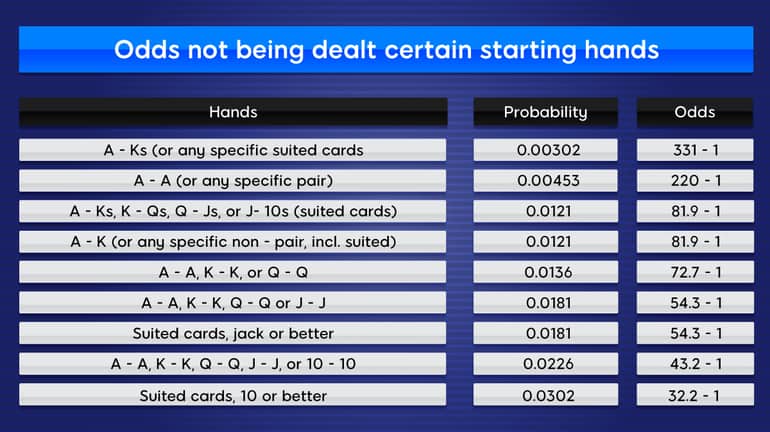Hand Odds
Posted : admin On 4/6/2022- Poker odds give you the probability of winning any given hand. Higher odds mean a lower chance of winning, meaning that when the odds are large against you it’ll be a long time until you succeed.
- Odds refer to how likely it is an event will occur. In poker, we are frequently calculating pot odds, which tells us, if we call a bet, how often we need to win the hand for the call to be at least breakeven. But how do I calculate the percentage of the pot odds?
Hand Odds Texas Hold'em
Odds against receiving a hand with 37 HCP (4 Aces, 4 Kings, 4 Queens, and 1 Jack) = 158,753,389,899 to 1 Odds against receiving a perfect hand (13 cards in one suit) = 169,066,442 to 1 Odds against a Yarborough = 1827 to 1.

-What are the odds of me hitting...
Based on the probability of how many ways particular hands that can be dealt at a table with seven cards from a 52 card deck, the way that you want to play your combinations is to achieve the higher ranking hands where probabilities aren't out of the range of 'realistic'. You also don't want to be playing hands that are far too common and can be easily beaten.
Hand | 7 cards |
| Straight Flush | 41,584 |
| Four of a Kind | 224,848 |
| Full House | 3,473,184 |
| Flush | 4,047,644 |
| Straight | 6,180,020 |
| Three of a Kind | 6,461,620 |
| Two Pair | 31,433,400 |
| One Pair | 58,627,800 |
| High Card | 23,294,460 |
Looking down the chart which is arranged from the highest possible made hand to the lowest hand, you see that there is a large mathematical leap between ways that a four-of-a kind hand and a full house can be dealt with seven cards. The range of realistically catching better than a full house comes to a screeching halt. There is another large gap between three-of-a-kind and two pair.
The starting hand combination strategy used for winning seven card stud hands, promotes aspiring to achieve the median; three of a kind or better. The odds of catching the median hands differ depending on how many players are at a table, how many players continue on to later betting rounds, and the type of hands that any player at a table is striving to achieve.
In my experience at fully seated low-stakes tables, it is not uncommon that players are using combinations that will make two pair or better. When playing for two pair, naturally you will want to have the highest two pair, and strategy is adjusted accordingly.
The table below shows odds for flushes and straights. You can determine your odds based on the number of persons in a multi-way pot. For example, if you have one card to draw to a flush, your best odds to catch your flush is to have 4-5 people calling bets. Straights happen most often at stud hi/low tables because there are so many people in the hand at a time, more closely matching the odds needed to catch that particular hand.
| Draw one card with | Odds |
| Four cards to a flush | 1 in 4.5 |
| Double open-ended straight | 1 in 5 |
| Open-ended straight (1 end) | 1 in 11 |
| Inside Straight | 1 in 11 |
| Double open-ended straight flush | 1 in 23 |
| Open-ended straight flush (1 end) | 1 in 46 |
| Inside Straight Flush | 1 in 46 |
| Rolled up with 3-of-a-kind | 40% chance of improvement to a full house by the river. |
More information on hand odds is available here.
Hand odds are the probability of drawing to the winning hand on the flop, turn or river. It’s typically calculated on the turn when you don’t currently expect to have the best hand but want to determine if calling a bet is profitable or not and whether you can expect to extract additional value on the river.

If you want to calculate your hand odds you have to know how many your hand has. Outs are defined as a card in the deck, which will help you to make your hand. In most situations when you do not know what your opponents hold, you can only do calculations with the knowledge that is available to you. And all that is available to you are your pocket cards and the cards on the table. It means that you are doing the calculations as if you were the only person at the table.
Another important thing is not to over count your odds when calculating outs. If you know how to correctly count the number of outs you have in your hand, you can easily calculate what percent of the time you will hit your hand by the river.
EXAMPLE “Calculating hand odds and pot odds becomes second nature after a while.”

Hand Odds Preflop
Related terms on PokerDictionary.net